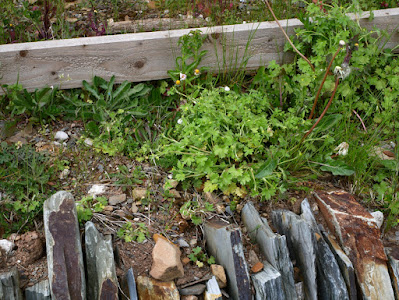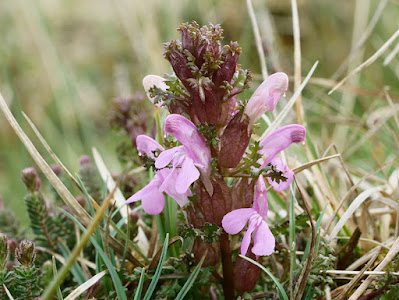Cornwall has stayed on the cold side of the jet stream for most of early Spring, so many species are flowering one to two weeks later than in previous years. However, frosts have been minimal and rainfall has been plentiful, so no Spring drought this year. This will enable the early annual species to have a good year and provide plenty of seed for the future too.
Many trees are flowering now including this Ash tree below with its odd looking petal-less flowers.
Fraxinus excelsior
Not quite a tree, but a woody shrub, is Bog Myrtle below. This is also flowering, again no petals present. All parts of this plant smell lovely when crushed, ironic given that it grows in foul smelling bogs!
Myrica gale
Water-crowfoots are coming into flower in the bogs too. This one below is Round-leaved Water Crowfoot with its bigger flowers and rounded lobes.
Ranunculus omiophyllus
In the drier parts of the heath, Pale Dog Violets were flowering. The colours of the petals vary from light purple to white and mostly somewhere in between. The easiest way to tell them apart from Common Dog Violets is to look at the leaves. In Pale Dog Violet these are more than x2 in length than the width and with small rounded teeth on the leaves. The leaves taper into the stems (cuneate) and are not heart shaped at the base (cordate).
Viola lactea
With the wet Spring so far, Marsh Violet has emerged in large numbers compared to 2022. The boggy areas were full of them. These have quite small flowers varying from white to lilac but have almost round leaves with cordate bases. The other common violets cannot grow in such wet conditions either. Note that (usually) the veins on the lower petal almost reach to the base.
In the car park of my local pub in Wadebridge, there is a cliff behind it. From a fault in the rocks runs a constant trickle of fresh water, thus creating a constant wet area on the rocks and a small pool below.
Growing here on the rockface were masses of the rare Maidenhair Fern (top centre), carpets of Opposite-leaved Golden Saxifrage (bottom centre), Pendulous Sedge (upper left), Great Willowherb (upper right) and Herb Robert (lower left). I even found Small Duckweed in the pool.
Adiantum capillus-veneris
Below, a close up of this lovely delicate fern with its black stems (rachis).
A tip off from my Vice County Recorder led me to a lay-by near Bodmin to see Dwarf Cherry, one I'd not seen before. It was indeed a dwarf tree and the stem was wavy and irregular with none of the tree much more than 10 metres tall. The flowers were very white with no hint of pink like Wild Cherry has. Quite a delightful tree and one that would grace any garden rather than those tasteless pink flowered imports that feed no native insects at all.
On an evening walk, I found a clump of Small-flowered Buttercup growing on top of a stone wall, not 100m from my house. It certainly wasn't there last year. Maybe that's the difference between a wet and a dry Spring? More seed from the seedbank is likely to germinate in wetter conditions I suppose.
Ranunculus parviflorus
The photo below was taken on the 26th April. Since then the roadside verges have filled with a multitude of Early Purple Orchids. One old wall-top on the road from Bodmin to Bugle had at least 80 flowering spikes on top of it. The ones below (A39 by Chapel Amble exit) had only just started to flower and just survived being mowed by about 30cm!
Orchis mascula
Of course, at this time of the year, I am still trying to identify and record some of the 230 or more Dandelion microspecies out there. I usually go for the tiny, delicate plants, but in a fit of madness, I collected this giant of a specimen from a nearby heathy area. Each leaf was around 30cm long.
Euthrix potatoria
Cornwall's milder climate means that many garden plants cross over the garden fence and do quite well in the wild. As such, I am often finding garden plants growing in the wild, and I occasionally find a plant that I've not seen before. This happened on a mud track lane near Bodmin where I found a bush with odd looking flowers on it. As it was close to a farmhouse entrance, I assumed it was likely planted for decoration, but I recorded it (as planted) in case it spreads, which is probable.
The bush was a Box-leaved Honeysuckle and had plenty of bumblebees around the flowers.
Back on heathland and Lousewort has flowered. It's now out in large numbers. It's a common plant and steals some of its nutrients from other plants by attaching its roots to its neighbours'.
Main roads are salted in the Winter and this allows a seaside plant called Danish Scurvygrass to cover the verges in tiny white flowers at this time of year. However, below is its larger relative, English Scurvygrass, that only lives in saltmarsh. In Cornwall it is nowhere near as common as Common Scurvygrass, so it's nice to find them. The one below was found next to the bridge crossing the River Camel at Wadebridge. It differs from the other two species by having diamond shaped leaves with a cuneate base and large flowers. English Scurvygrass has rounded leaves with a heavily cordate base but here it is often found inland and on sea cliffs.
My final plant for the end of April was on a trip to Par Sands hunting Dandelions. I failed to find any of significance, but I did notice the Sea Sandwort coming into flower. Sadly, they live in areas where holidaymakers will flatten them completely with towels and trampling. But, enough will set seed before they arrive in the Summer, thus ensuring their survival. I adore the symmetry of their leaves.






























